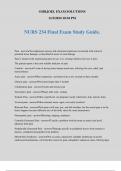©SIRJOEL EXAM SOLUTIONS
11/3/2024 10:54 PM
NURS 234 Final Exam Study Guide.
Pain - answer✔An unpleasant sensory and emotional experience associated with actual or
potential tissue damage, or described in terms of such damage
Pain is whatever the experiencing person says it is, existing whenever he says it does
The patient report is the most reliable indicator of pain
Comfort - answer✔A state of having basic human needs met, allowing for ease, relief, and
transcendence
Acute pain - answer✔More temporary- anywhere from a few seconds to three months
Chronic pain - answer✔Persistent longer than 3 months
Combination pain - answer✔Acute and chronic pan
Nociceptive pain - answer✔Sharp, dull, achy, crampy
Somatic Pain - answer✔More superficial, can pinpoint exactly what hurts, skin, muscle, bone
Visceral pain - answer✔More internal, more vague, not easily localized
Referred Pain - answer✔Feel pain in left arm, jaw, and left shoulder, but the actual pain is in the
heart, happens because different ares of the body share the same dermatomes
Neuropathic pain - answer✔Burning, tingling, numbness
Centrally Generated Pain - answer✔Usually a problem with the brain or spinal cord itself,
phantom limb pain
Peripherally Generated Pain - answer✔Damage specific to peripheral nerves from trauma or
disease , peripheral neuropathy from diabetes
Mixed Pain Syndrome - answer✔Not as easily categorized, multiple underlying or poorly
understood mechanisms, can't find the reason for pain, idiopathic= unknown cause, fibromyalgia
, ©SIRJOEL EXAM SOLUTIONS
11/3/2024 10:54 PM
What is the subjective assessment for pain? - answer✔What the patient says
Individuals at risk for pain - answer✔Acute or traumatic injury- burns, car accidents
Medical procedures- more invasive they are the more pain is suspected, intraoperative and
postoperative expected pain
Chronic conditions- bone cancer
Populations at risk for pain - answer✔Infants- looking for external cues (crying)
Children- use parents or caregivers to understand normal behavior and demeanor, behavior and
physiological cues
Adults and older adults
How to assess pain in adults and older adults - answer✔Pacing, if their mood if different,
agitation, grimacing, moaning, yelling, crying out, clenching, tension in face, decreased appetite,
decreased sleep, guarding, sudden resistance for help, may try to hide it
Why are adults and older adults more at risk for pain - answer✔Physical state (body
composition, muscle mass decreased, body fat increases, percentage of their body water
decreases, slower metabolism, nutrition is more at risk, more chronic conditions, multiple health
conditions that can cause problems with each other, more fatigue, dementia, just because some is
old does not mean that they have pain
How to assess pain in individuals unable to communicate - answer✔Pacing, mood is different,
agitation, grimacing, moaning, yelling, crying, clenching, tension, decreased appetite, decreased
sleep, guarding
Assessment tools for pain in comatose, dibbled, and dementia patients - answer✔0-10 pain scale
Visual face spectrum (are 4-7)
FLACC pain rating scale- know when it is appropriate to use it and know what to assess
Face- grimacing, frown, withdraw, disinterest, quivering, clenched jaw
Legs- uneasy, restlessness, tense, kicking or legs drawn up
Crying- moaning or whimpering, occasional complaint, crying, screaming, sobs
Consolability
Consequences of untreated pain - answer✔Endocrine/Metabolic Imbalance
, ©SIRJOEL EXAM SOLUTIONS
11/3/2024 10:54 PM
Cardiovascular instability
Respiratory Dysfunction
Genitourinary Disturbances
Decreased Gastrointestinal motility
Musculoskeletal Disturbances
Neurological disturbances
Reduced Immune Competence
Prolonged Stress Response
Developmental issues
Endocrine/Metabolic Imbalance as a result of untreated pain - answer✔Glucose intolerance
(released as a stress response)- hyperglycemia
Fluid overload
Cardiovascular instability as a result of untreated pain - answer✔Increased heart rate
Increased blood pressure or hypertension-overtime will wear down cardiovascular system (DVT,
myocardial infarction)
Respiratory Dysfunction as a result of untreated pain - answer✔Increased respiratory rate
Atelectasis
Pneumonia
Genitourinary Disturbances as a result of untreated pain - answer✔Urinary tension or hurts to
pee so they don't want to go
Decreased urinary output
Decreased gastrointestinal motility as a result of untreated pain - answer✔Anorexia
Constipation
Paralytic ileum (paralysis of the intestine- bowel obstruction which causes inability to pass stool
or gas
Musculoskeletal Disturbances as a result of untreated pain - answer✔Immobility




